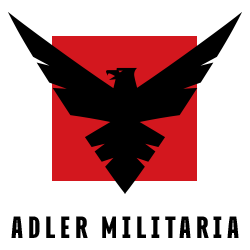Showing 1–9 of 33 resultsSorted by latest
-
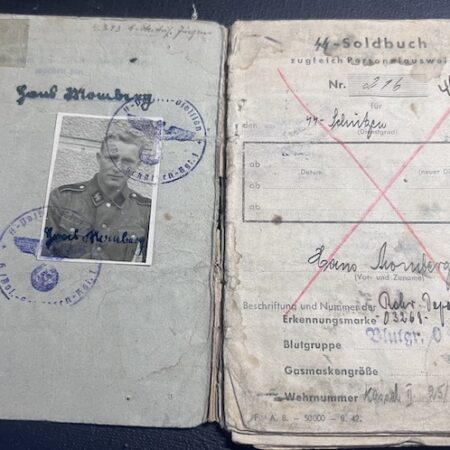
Original WWII German Waffen SS Soldbuch – SS Schütze Han Homberg – SS Sniper MIA / KIA – Gesichtsmaske – SS Panzer Grenadier Regiment 7 (Reserved)
Nice original Soldbuch from an SS Sniper, Served with SS Polizei Panzer Grenadier Regiment 1 The regiment remained outside Leningrad throughout 1942, participating in the heavy defensive battles there. On January 12, 1943, the Red Army launched its winter offensive on the northern front. When Russian troops managed to break through to the south of the XXVI Army Corps, the SS Police Division, including the 1st SS Police Infantry Regiment, received orders four days later to liberate Schlüsselburg and free the German troops trapped there. However, the Germans were unable to mount any resistance to the Russian attacks. Schlüsselburg had to be abandoned. During the heavy fighting in the Sinyavino area, the SS Police Division was almost completely destroyed. On January 29, 1943, the remnants of the regiment were withdrawn from the front and transferred to the LIV Army Corps. The division reassembled in Sablino. Nominally, the regiment was renamed SS Police Grenadier Regiment 1 here on February 1, 1943. In practice, the division’s three SS Police Grenadier Regiments were reduced to three weak battalions. The division received 1,200 replacements from Germany on February 9, 1943. Fighting subsided at the end of February 1943. On March 18, 1943, the Red Army launched another offensive, but halted it after two weeks. A comprehensive reorganization of the division and regiment then began at the Heidelager training area, culminating in its transformation into SS Police Panzergrenadier Regiment 1 on June 6, 1943. On October 22, 1943, the regiment was finally renamed SS Panzergrenadier Regiment 7. SS Panzer Grenadier Regiment 7 The regiment was formed on October 22, 1943. Initially, it bore the name SS Police Panzergrenadier Regiment 1, which in turn had previously been called SS Police Infantry Regiment 1. The regiment was subordinate to the 4th SS Police Panzergrenadier Division. On June 10, 1944, the regiment killed over 300 Greek civilians near Distomo following a partisan attack. It seems that shortly after he was deployed again with the division on the Eastern Front. Although by that stage of the war the front was on Germanys doorstep (Poland) where he was reported to have went MIA/KIA in February 1945. Equipment One of the rarest entries I have seen to date in the equipment list is the issuing of all three items together, in July 1943. Tarnjacke (SS Camo Jacket or Smock), Stahlheluberzug (SS Helmet Cover), Gesichtsmaske (Face Mask!!). Also note the issing of a Sniper Scope at the top of the weapons/equipment page for July 1943 the same time he was given the full camo equipment.
-
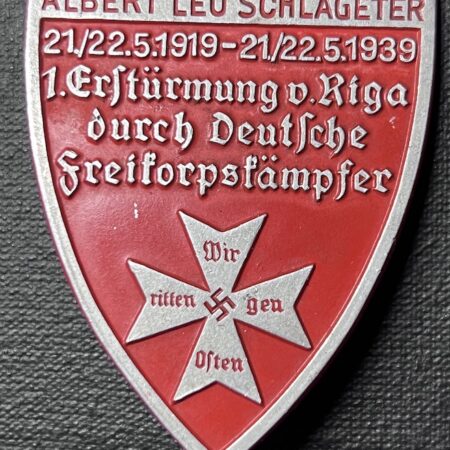
Original WWII German Freikorps Medal 1919 – 1939 – Albert Leo Schlageter – First Storming of Riga Deutsche Friekorpskämpfer – Very Rare Large Badge
$275.00Here we have a very rare badge commemorating the first Freikorps Storming of Riga in April 1919. “Albert Leo Schlageter” Schlageter was a Freikorps member executed by the French in 1923 for sabotage during the Ruhr occupation. In the Nazi era he was elevated to a propaganda martyr, so 1930s and WWII-era organizations produced commemorative badges and medals in his name. “First Storming of Riga” Refers to the Freikorps capture of Riga (Latvia) in May 1919 during the chaotic post-WWI conflicts in the Baltics. Badges commemorating the “Storming of Riga” were made for veterans of the Iron Division (Eiserne Division) and other Freikorps units. “Deutsche Freikorpskämpfer” Many commemorative or veterans’ organization badges used this wording in the 1920s–1930s. The Badge is made by Wilhelm Helbing, Leipzig W33 Measures 6cm long and 5cm wide
-
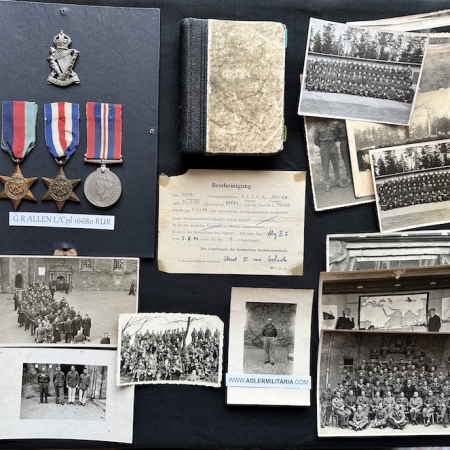
-

Original WWII German Silver Ceremonial Bowl – Reichsleiter/SS-Obergruppenführer Walter Buch – Beer Hall Putsch 1923- Stosstrupp Hitler – Ernst Rohm Execution – Kristallnacht 1938 – Extremely Rare Item
$4,750.00A very interesting Third Reich Ceremonial Bowl made by Kleemann of Munich in 925 Silver, Commemorating the 5th Edition of the “Brown Ribbon of Germany” and presented to the then Reichsleiter Walter Buch (see below for history). Reichsleiter & SS-Obergruppenführer Walter Buch Walter Buch (October 24, 1883-November 12, 1949) is one of the more mysterious and intriguing characters of the 3rd Reich. Head of the Nazi Party Courts, father-in-law to Martin Bormann, Reichsleiter, and NSDAP member since its earliest days in 1922, Buch relished his role as Hitler confidant and advisor. A vehement anti-semite, he was a vigorous defender and promoter of National Socialist ideology and did much to legitimize Party actions considered controversial at the time. Buch took part in the Beer Hall Putsch in 1923, was one of the founding members of the Stoßtrupp-Hitler (precursor to the SS) Personally recognized by Hitler as a champion of the Party and its profound mission, Buch rose to numerous titles within the Third Reich thanks in part to unquestionable loyalty to the NSDAP. He was personally in attendance for Ernst Rohm’s arrest and execution, and was also responsible for the legitimization of Kristallnacht, rendering the participants free of responsibility. As the Supreme Judge of the Nazi Party Court system, Buch was able to settle disputes within the Party between members with absolute finality, as the only recourse was to appeal to Adolf Hitler himself. An enormously powerful man, Buch, who was arrested following the war and found guilty of the of worst war crimes, took his own life in 1949. More information on Buch can be found here: Following Awards: Golden Party Badge, Blood Order, Deaths Head Ring, SS Honour Sword and more… https://www.tracesofwar.com/persons/83364/Buch-Walter.htm https://en.wikipedia.org/wiki/Walter_Buch A little History on the Brown Ribbon of Germany: The Brown Ribbon of Germany was a Horse – flat race held during the Third Reich at the Riem racecourse in Munich. The race for the “Brown Ribbon of Germany,” a 2400-meter flat race for three-year-olds and older, was part of and the highlight of the “International Riem Racing Weeks ” From 1934 to 1944, the races were held annually in the summer. The races had a distinctly international character. Besides horses from Germany, the winning horses in the annual Brown Ribbon races came from France and Italy. The most famous winner was Heinrich Thyssen’s Nereide from the Erlenhof Stud, who won in 1936. The purse for the inaugural race was 19,500 Reichsmarks, rising to 50,000 Reichsmarks in 1935, and subsequently reaching 100,000 Reichsmarks. This made it one of the richest horse races in Europe. The “Brown Ribbon” for the first-placed horse is a sash in brown color. This item is extremely rare, as anything remotely related to Buch is just not on the market. Price Includes World Wide Tracked Shipping. https://www.youtube.com/watch?v=4A5_03u8XSc
-

WWII Luftwaffe Stuka Pilot Oblt Wanner Soldbuch & Wehrpass Set – Ju 87 D-5 – 189 Missions! – Missing in Action – FFS Gold – Ultra Rare
$1,850.00We lately got in a set of nice documents, coupled by the former collector with original awards. Although they were not the pilots awards and are offered here separately, we do not split groups that belong together. Oberleutnant Will Wanner Born in 1920, he was enlisted after volunteering in the Luftwaffe in 1940. He went though almost three years of schooling on the Stuka before joining his Stuka unit in December of 1942. Wanner served with III/ Sturzkampfgeschwader 77 1943 SG 77 seen extensive action on the Eastern Front. By 20 December 1942 III./StG 77 had only seven serviceable dive-bombers. III./StG 77 lost 29 ground crew on the retreat from Rossosh to Kharkov. It probably took part in the air battles but was decimated and withdrawn to Würzburg. It was rebuilt with 37 Ju 87s and 245 officers and sent to Luftflotte 2, II. Fliegerkorps. The group moved to Cagliari, but was not to be used until the Allied invasion of Sicily (Operation Husky). In the event, the airfields were so badly damaged on the island it was ordered to return to IV. Fliegerkorps on 27 April 1943 On 8 July, StG 77 supported the Großdeutschland against the fortified village of Syrtsevo. StG 77 lost five Ju 87s and another damaged in combat with the 240 IAP. The air corps claimed, with contributions from SG 1, 84 Soviet tanks destroyed, 21 damaged, 40 vehicles destroyed, and five artillery pieces along with two anti-aircraft guns and two rocket launchers. By the evening of 8 July, 16 dive-bombers had been lost. The Germans halved the amount of Stuka sorties over the ensuing days. On 11 July, 9./StG 77, under III./StG 77 lost another five Ju 87s as it supported attacks against the 69th Army. The 183 IAP were their attackers. In the afternoon, 50 Ju 87s supported the 1st SS Panzer Division Leibstandarte SS Adolf Hitler’s attack on Hill 252.2. On 12 July StG 77 was involved in the Battle of Prokhorovka. While the Ju 87s could only fly 150 sorties in support, but with StG 2 the attacked with great success against Soviet armour advancing in the open. The 31st Tank Brigade, of the 29th Tank Corps, suffered heavy casualties. The 36th Tank Brigade’s commander was wounded by aircraft when his tank was destroyed. On 14 July, another six Ju 87s were lost supporting the XXXXVIII Panzer Corps The German offensive continued in the southern sector, but Operation Roland failed and the Red Army took time to begin the counter offensive, Operation Polkovodets Rumyantsev. Soviet forces slowly pressed the Germans back. On 19 July 7./StG 77 was wiped out by a Soviet attack on the base at Kramatorskaya and 4./StG 77 lost another three to Soviet fighters. At the beginning of August 1943, the Soviet summer counter offensives began. StG 77 lost 24 dive-bombers and 30 damaged between 5 and 31 July 1943. Their losses from July to December 1942 were just 23. The Stuka arm had also lost eight Knight’s Cross of the Iron Cross holders—Karl Fitzner of 5./StG 77 was one of them; he was shot down and killed on 8 July.III./StG 77 operated in the Kharkov and Belgorod sectors, after the fall of the latter on 5 August. From 6 to 12 August it lost four Ju 87s in combat and another three in the retreat to prevent their capture. On 17 August it was at Poltava, and the following day 7./StG 77 lost another four in combat near Sumy; four men were killed and two wounded. The group retreated to Stalino and lost another three on 2 and 3 September while 8. and 9. Staffel lost two Ju 87s near Kharkov on 5 September. Awards 4.12.1941 – Pilots Badge 8.7.1943 – Iron Cross Second Class 8.7.1943 – Front Flying Clasp in Bronze 26.7.1943 – Iron Cross First Class 24.7.1943 – Front Flying Clasp in Silver 6.2.1944 – Front Flying Clasp in Gold He flew a total of 189 Missions, according to the Luftwaffe Officer Lists he was shot down by Anti Aircraft Fire over Bialystok. WANNER, Willi. 01.06.44 promo to Oblt./A1. 27.07.44 Oblt., 7./SG 77 MIA – Ju 87 D-5 (S2+CR) shotdown by AA vic Bialystok. According to the German War graves online archive he was never buried… The both Certificates for the Front Clasps are attached to a card by the previous collector. Condition is as photographed.
-

WWII Waffen SS Soldbuch – SS Sturmmann Wichmann – SS Jäger Btl 500 – Wounded Fighting Partisans – SS-Jagdverbände – Very Rare Unit
$1,750.00Here we have a rather rare SS Unit, I have not seen any to this unit in many years dealing in IDs. Siegmund Wichmann was born in 1923 in Romania. He was enlisted/Volunteered for the Waffen SS in April 1943 with: Stammkompanie / SS Grenadier Ersatz Btl “Ost” After training he was posted to his frontline unit: SS Grenadier Ausbildungs Btl “Ost” SS Jäger Btl 500 – Stabskompanie Commander SS-Sturmbannführer Beilhack Manpower strength 30 June 1944 – 1.271 SS-Jäger-Btl 500 was under the administrative command of 292. Infanterie-Division, which was part of Armee Gruppe Mitte from June 1941 to January 1945. A quick bit of research shows the divisional commander from 30.6.1944 to 1.9.1944 to have been Generalmajor Johannes Gittner. SS-Jäger-Btl 500 was engaged in security and anti-partisan operations behind the German lines during its time with 292. SS-Jäger-Btl 500 was disbanded in October 1944, the survivors being sent to SS-Panzergrenadier-Ausbildungs und Ersatz Btl 35, which was the depot of the SS-Jagdverbände and SS-Fallschirmjäger-Btl 500 and 600. Tessin: SS-Jäger-Btl.500 * 15. 4. 1944 zu 5 Kpn. aus dem Jäger-Btl. der Nachschub-Kdtr. Rußland-Mitte in Moorlager (Bereza-Kartuska bei Brest-Litowsk); im Partisaneneinsatz Mittelrußland, zuletzt Sept. 1944 bei Warschau; Okt. 1944 aufgelöst; Abwicklung beim SS-A usb.und Ers.Btl. 35 in Konitz. U: Sondertruppe RF -SS In March of 1945, it seems he was issued combat equipment once again including a rifle for combat with his replacement unit. SS Grenadier Ausbildungs und Ersatz Batl 25 – Konitz Westpreussen Interestingly, SS-Jagdverbände merely used SS-Panzer-Grenadier-Ausb.u.Ers.Btl. 35 as a ‘cover’. SS-Führungs-Hauptamt order of 1.12.1944 changes the nomenclature from SS-Grenadier-Ausbildungs und Ersatz-Bataillon 35 to SS-Panzer-Grenadier-Ausb.u.Ers.Btl. 35 with effect from 15.11.1944. The latter designation was used as early as October 1944 in paybooks issued to members of SS-Fallschirmjäger-Btl 600 and the SS-Jagdverbände. Promoted SS Sturmmann – February 1945 – SS Grenadier Ersatz Btl 35 Awards Black Wounds Badge – Wounded on the 15th of July 1944 – fighting Partisans Given in June of 1944 a special Führer Paket along with money. Last comments Very rare unit, directly engaged with fighting partisans.
-

Original WWII German General Gause Photo Album – Rommel Inspection Denmark 1943 – Sabotage Troops – Atlantic Wall – Hanstholm – Very Rare Images
$3,495.00Extremely Rare Images of Rommel In Denmark Taken By General Gause.
-
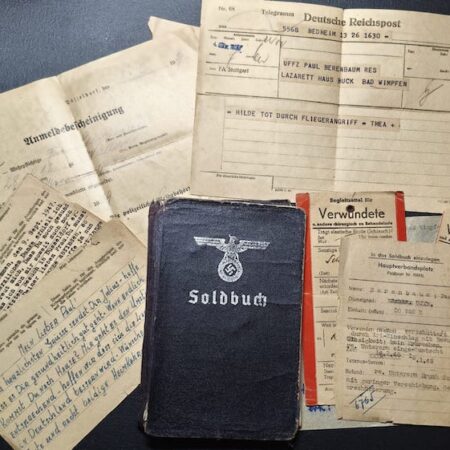
WWII Wehrmacht Soldbuch Grouping – Uffz Paul Berenbaum – Born in France! – Incredible Story Buried Alive by US Artillery – Grenadier Regiment 713 – 416 Inf Div West Wall 1945 – Mortar Team Leader – Rare!
$565.00Here we have a really tragic Soldbuch Grouping… Paul Berenbaum was born in Wallern (Vallieres Les Metz) France. He was enlisted into the German Army in February 1940. In 1940/1941 he served with: Infanterie Regiment 178 – 76 Infanterie Division – On the Western Front then in Poland. In 1942 he served with: Infanterie Regiment 441 – 416 Infanterie Division They served in Denmark, more can be found here including the places in which they were posted: https://www.lexikon-der-wehrmacht.de/Gliederungen/Infanteriedivisionen/416ID.htm In 1943/44 he served with Landeschützen Regiment 930 shortly before being assigned to Grenadier Regiment 713 in late 1942/early 1943. But by late 1944 he was assigned to the Feld Ersatz Batl 476 – 416. Infanterie-Division Issued a MP40 Machine Pistol On October 11, 1944, the division established a command post in Keuchingen near Mettlach/Saar. After the start of the Allied offensive across the Moselle on November 9, 1944, elements of the division were deployed in the ensuing defensive battles around Freching and Kerling. On November 17, 1944, the division’s command post was located in Tünsdorf, on November 18 in Orscholz, and on November 19 in Trassem. On November 28, the division headquarters was in Taben, and on December 3 in Taben-Rodt. On December 4, 1944, after a month of defensive fighting, the division still had a combat strength of 2,400 men, of whom 1,550 were infantry. Heavy fighting ensued around the West Wall, followed by a retreat to the Mettlach area and the Orscholz ridge. On January 14, 1945, the division still had a strength of 3,016 men. In the following weeks, the fierce defensive battles continued at the Orscholz ridge/Saar-Moselle triangle. Between February 7 and 28, 1945, the division suffered 2,195 casualties. According to his wounding tags, he was delivered on the 15.1.1945 in St Wendel with a suspected broken bone from being stuck/squeezed. According to a rather rare (never seen before) Soldbuch Paper which was to be put into the Soldbuch given by the main aid station (Hauptverbandplatz): “Verschüttet durch Artillerie einschlag mit Bewusstlosigkeit; kein erbrechen rechten unter arm eingequetscht” “Buried by artillery fire, unconscious; no vomiting, right arm crushed” After being examined the Doctor found his right arm was broken at the elbow, and he was suffering from concussion. He was transferred to Bad Wimpfen where he was to rest according to another piece of paper issued by the Hospital, although he would get a Telegram from his Wife that his relative Hilde was killed during an allied bombing raid on the 4th of March 1945. He would spend till the 28th of May 1945 in hospital recovering, before going into a POW Camp Nr 172 in Vernet d Àviege which was in fact a former Concentration Camp. https://en.wikipedia.org/wiki/Camp_Vernet Two Letters sent by his friend Julius Niggemann in 1947 read: My dear Paul! Warmest greetings from Julius. I hope you are in good health. When will you finally come home? Considering the circumstances, we hope that the situation in Germany will soon improve. I wish you all the best and a speedy return home – your Julius! My dear Paul! With heartfelt thanks I received your kind lines. I am glad to hear that you are still healthy and in good spirits — as far as I can say, I am as well. During my last visit to Düsseldorf, I unfortunately learned of the death of your dear wife. You must come to terms with this sad fact, however difficult the loss must be for you. I do hope now, with confidence, that you will soon be released. It truly is about time that our authorities finally come to that realization as well. Düsseldorf looks desolate, and yet, despite everything, new life is springing up from the ruins again. I am always amazed at how people manage to carry on with life. For today, I wish you all the best. Stay healthy and in good spirits until we can have a joyful reunion back home. Your ever-thoughtful friend. It seems his wife Thea Berenbaum died in December of 1945. Lastly a letter dated 18.6.1948 to the now released Paul Berenbaum living in the British Zone of Germany in Munster / Westfalhen shows that he made it out alive. Last comments His story is a tragic story, from being buried alive in combat and miraculously being pulled from the rubble unconscious, loosing family by bombing raids and later his wife whilst he was interned in a former Concentration Camp. A horrible time he experienced, one can only hope he lived peacefully after the war.
-
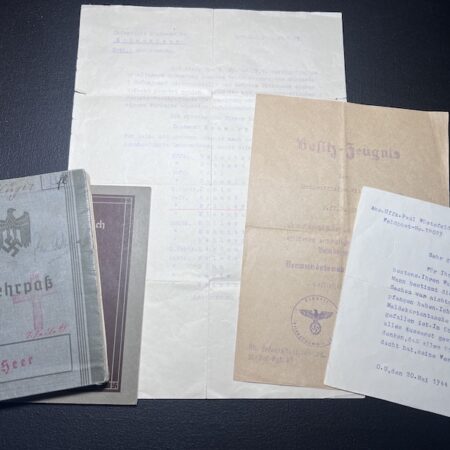
WWII German Wehrmacht Wehrpass KIA Grouping -Oberfeldwebel Pflüger – Saar Offensive 1939 Action Report – IR81 WIA France 1940 – Black Wounds Badge Certificate Le Hamal (Rare version!) Streifendienst – Grenadier Regiment Lublin
$375.00Interesting little grouping to Oberfeldwebel Pflüger Very interesting and unusual entry is that in September of 1939, he took part in the battle known as the Saar Offensive – when France invaded the Saarland in 1939!! “During a reconnaissance operation carried out by the 9th Company on 27 September 1939, despite difficult circumstances (captured prisoners, heavy rain, and several French soldiers put out of action), the mission was successfully completed. Through exceptional prudence and execution of the operation, it was possible to achieve success with minimal own losses.I express my recognition to the leader of the reconnaissance patrol” He was fighting in France with Infanterie Regiment 81, and was injured in a battle with French Soldiers in Le Hamal in June 1940. Medals: West Wall Medal, Iron Cross, Wounds Badge in Black He would serve in various other units including Streifendienst! Not often seen! He was later killed in action with Grenadier Regiment Lublin in Poland 1944. Final Comments The fact that he was involved in operations in September 1939 makes this grouping one of a kind, not many units actually took part in the fighting during the Saar Offensive, but having the typed letter naming him surely makes this quite a desirable item.
